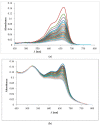Biogenic Gold Nanoparticles Decrease Methylene Blue Photobleaching and Enhance Antimicrobial Photodynamic Therapy
- PMID: 33504099
- PMCID: PMC7865674
- DOI: 10.3390/molecules26030623
Biogenic Gold Nanoparticles Decrease Methylene Blue Photobleaching and Enhance Antimicrobial Photodynamic Therapy
Abstract
Antibiotic resistance is a growing concern that is driving the exploration of alternative ways of killing bacteria. Here we show that gold nanoparticles synthesized by the mycelium of Mucor plumbeus are an effective medium for antimicrobial photodynamic therapy (PDT). These particles are spherical in shape, uniformly distributed without any significant agglomeration, and show a single plasmon band at 522-523 nm. The nanoparticle sizes range from 13 to 25 nm, and possess an average size of 17 ± 4 nm. In PDT, light (from a source consisting of nine LEDs with a peak wavelength of 640 nm and FWMH 20 nm arranged in a 3 × 3 array), a photosensitiser (methylene blue), and oxygen are used to kill undesired cells. We show that the biogenic nanoparticles enhance the effectiveness of the photosensitiser, methylene blue, and so can be used to kill both Gram-positive (Staphylococcus aureus) and Gram-negative (Escherichia coli) bacteria. The enhanced effectiveness means that we could kill these bacteria with a simple, small LED-based light source. We show that the biogenic gold nanoparticles prevent fast photobleaching, thereby enhancing the photoactivity of the methylene blue (MB) molecules and their bactericidal effect.
Keywords: LED; antibacterial PDT; antibiotic resistance; biogenic gold nanoparticles; methylene blue.
Conflict of interest statement
The authors declare no conflict of interest.
Figures








Similar articles
-
Development of therapeutic Au-methylene blue nanoparticles for targeted photodynamic therapy of cervical cancer cells.ACS Appl Mater Interfaces. 2015 Jan 14;7(1):432-41. doi: 10.1021/am5064298. Epub 2014 Dec 19. ACS Appl Mater Interfaces. 2015. PMID: 25494339
-
Bovine serum albumin-capped gold nanoclusters conjugating with methylene blue for efficient 1O2 generation via energy transfer.J Colloid Interface Sci. 2018 Jan 15;510:221-227. doi: 10.1016/j.jcis.2017.09.011. Epub 2017 Sep 19. J Colloid Interface Sci. 2018. PMID: 28946047
-
Comparative Study on Photodynamic Activation of Ortho-Toluidine Blue and Methylene Blue Loaded Mesoporous Silica Nanoparticles Against Resistant Microorganisms.Recent Pat Drug Deliv Formul. 2018;12(3):154-161. doi: 10.2174/1872211312666180627093316. Recent Pat Drug Deliv Formul. 2018. PMID: 29952275
-
Gold mining for PDT: Great expectations from tiny nanoparticles.Photodiagnosis Photodyn Ther. 2015 Jun;12(2):221-31. doi: 10.1016/j.pdpdt.2015.03.002. Epub 2015 Mar 26. Photodiagnosis Photodyn Ther. 2015. PMID: 25818545 Review.
-
Photosensitiser-gold nanoparticle conjugates for photodynamic therapy of cancer.Photochem Photobiol Sci. 2018 Nov 1;17(11):1534-1552. doi: 10.1039/c8pp00271a. Epub 2018 Aug 17. Photochem Photobiol Sci. 2018. PMID: 30118115 Review.
Cited by
-
Methylene Blue-Based Nano and Microparticles: Fabrication and Applications in Photodynamic Therapy.Polymers (Basel). 2021 Nov 16;13(22):3955. doi: 10.3390/polym13223955. Polymers (Basel). 2021. PMID: 34833254 Free PMC article. Review.
-
A Study on Mesoporous Silica Loaded With Novel Photosensitizers HCE6 and Oxaliplatin for the Treatment of Cholangiocarcinoma.Front Oncol. 2021 Jun 29;11:665182. doi: 10.3389/fonc.2021.665182. eCollection 2021. Front Oncol. 2021. PMID: 34268112 Free PMC article.
-
Photodynamic Inactivation Effectively Eradicates Candida auris Biofilm despite Its Interference with the Upregulation of CDR1 and MDR1 Efflux Genes.J Fungi (Basel). 2022 Oct 27;8(11):1137. doi: 10.3390/jof8111137. J Fungi (Basel). 2022. PMID: 36354904 Free PMC article.
-
Delta SARS-CoV-2 inactivation and bactericidal performance of cotton wipes decorated with TiO2/Ag nanoparticles like Brazilian heavy-fruited Myrciaria cauliflora.Mater Today Commun. 2022 Dec;33:104288. doi: 10.1016/j.mtcomm.2022.104288. Epub 2022 Aug 22. Mater Today Commun. 2022. PMID: 36033158 Free PMC article.
-
Analysis of the Results of Severe Intraepithelial Squamous Cell Lesions and Preinvasive Cervical Cancer Phototheranostics in Women of Reproductive Age.Biomedicines. 2022 Oct 9;10(10):2521. doi: 10.3390/biomedicines10102521. Biomedicines. 2022. PMID: 36289783 Free PMC article.
References
-
- Maclean M., Macgregor S.J., Anderson J.G., Woolsey G.A., Coia J.E., Hamilton K., Taggart I., Watson S.B., Thakker B., Gettinby G. Environmental decontamination of a hospital isolation room using high-intensity narrow-spectrum light. J. Hosp. Infect. 2011;76:247–251. doi: 10.1016/j.jhin.2010.07.010. - DOI - PubMed
MeSH terms
Substances
Supplementary concepts
Grants and funding
LinkOut - more resources
Full Text Sources
Other Literature Sources
Miscellaneous

